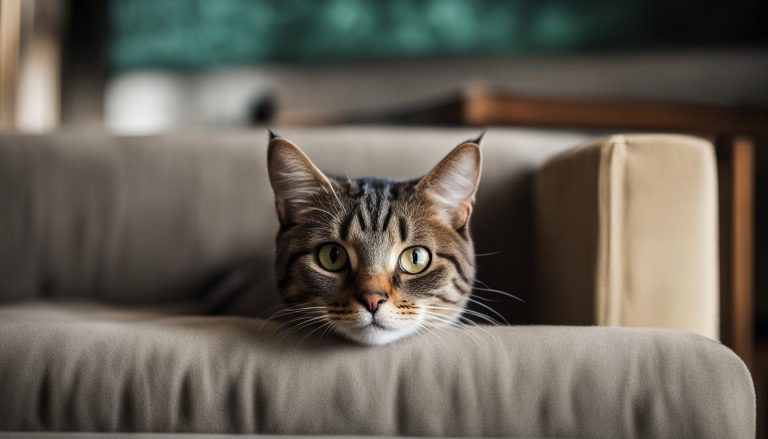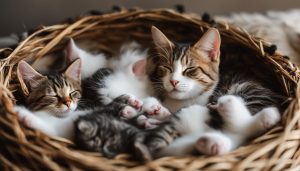Cats are mysterious creatures with unique behaviors that can sometimes leave pet owners puzzled. By decoding these behaviors, we can deepen our bond with our cats and provide them with the care they need. This comprehensive guide will provide insights into common cat behavior issues and offer tips and solutions for addressing and managing these behaviors. From understanding why cats engage in specific actions to strategies for preventing and solving behavior problems, this article will equip pet owners with the knowledge they need to foster a harmonious relationship with their feline friends.
Key Takeaways:
- Understanding cat behavior is crucial for creating a strong bond with your furry friend.
- Common cat behavior issues can be addressed and managed with the right knowledge and strategies.
- Preventing cat behavior problems requires providing mental and physical stimulation.
- Genetics play a role in shaping cat behavior and instincts.
- Decoding cat body language and vocalizations can help us better understand our cats’ needs and emotions.
Cat Behavior: The Influence of Genetics
Although domestic cats no longer need to hunt for survival like their ancestors, their genetic makeup still plays a significant role in influencing their behavior. Understanding the genetic factors that contribute to specific behaviors can provide valuable insights into why cats behave the way they do.
Genetics influence a wide range of feline behaviors, including:
- Frequent napping
- Grass nibbling
- Hunting instincts
By acknowledging the genetic influence on cat behavior, pet owners can better understand and respond to their cats’ needs, creating a more enriching and fulfilling environment for their feline companions.
One of the significant impacts of genetics on cat behavior is their instinctual hunting behavior. Cats have a natural inclination to hunt prey, even if they don’t need to for survival. This behavior is deeply rooted in their genetic makeup and contributes to their overall behavior patterns.
Understanding the role of genetics in cat behavior can help pet owners address certain behaviors and provide appropriate outlets for their cats’ innate instincts. By recognizing genetic influences, owners can create a stimulating environment that focuses on a cat’s natural inclinations.
Decoding Common Cat Behaviors
Cats are fascinating creatures that communicate through various behaviors. Understanding these behaviors is essential for pet owners to meet their cats’ needs and emotions. Decoding cat behaviors involves interpreting their body language and vocalizations, allowing us to establish a deeper connection with our feline companions.
1. Understanding Cat Body Language
Cats use their bodies to express their emotions and communicate with us. Here are some key body language signals to help decipher what your cat is trying to convey:
- Tail Position: A relaxed tail indicates contentment, while an erect, puffed-up tail may signify fear or aggression.
- Ear Position: Forward-facing ears indicate alertness or interest, while flattened ears may signal fear or aggression.
- Pupil Dilation: Dilated pupils can indicate excitement or fear, while constricted pupils may suggest aggression or stress.
2. Deciphering Vocalizations
Cats use a variety of vocal sounds to communicate their needs and emotions. Here are some common vocalizations and their possible meanings:
- Meowing: Cats often meow to get attention, express hunger, or greet their owners.
- Purring: Purring can indicate contentment, but cats may also purr when they are in pain or stressed.
- Hissing: Hissing is a defensive vocalization that cats use to express fear or aggression.
- Chirping: Cats may chirp when they see prey, expressing their natural hunting instincts.
Understanding cat behaviors is crucial for building a harmonious relationship with your feline friend. By observing their body language and vocalizations, you can better understand their needs and emotions, ensuring their well-being and happiness.
Additional Tips for Decoding Cat Behaviors:
- Pay attention to your cat’s environment, as external factors can influence their behavior.
- Observe your cat’s behavior patterns and look for any changes or inconsistencies.
- Consult with a veterinarian or animal behaviorist for professional guidance if you are unsure about your cat’s behaviors.
Addressing Aggression in Cats
Aggression in cats can be a concerning behavior that pet owners may struggle to understand and manage. It can manifest in various forms, such as hissing, swatting, biting, or growling. This section explores effective strategies for addressing and managing cat aggression, ensuring a safe and harmonious environment for both the cat and its owner.
Understanding the Causes of Cat Aggression
Cat aggression can stem from various underlying factors, including:
- Anxiety or Fear: Cats may display aggression when they feel threatened or scared.
- Territorial Instincts: Cats are naturally territorial and may become aggressive to protect their space.
- Pain or Medical Issues: Cats in pain may exhibit aggressive behavior as a defensive response.
By understanding the root cause of aggression, pet owners can develop effective strategies to manage and reduce aggressive tendencies in their cats.
Creating a Safe and Enriched Environment
Providing a safe and enriched environment is crucial for managing cat aggression. Here are some tips:
- Ensure your cat has plenty of hiding spots and elevated areas to retreat to when they feel stressed or overwhelmed.
- Offer interactive toys and engaging activities that stimulate your cat’s mind and help release pent-up energy.
- Establish a consistent routine and maintain a peaceful atmosphere in the household.
By creating a positive and secure environment, you can help alleviate anxiety and reduce the likelihood of aggressive behavior in your cat.
Positive Reinforcement Training
Positive reinforcement training can be an effective tool for managing cat aggression. By rewarding desired behaviors and redirecting negative behavior, you can encourage your cat to adopt more appropriate responses in challenging situations.
When your cat displays calm and non-aggressive behavior, reward them with treats or praise. Avoid punishment, as it can escalate aggression and undermine the training process.
Seeking Professional Help
If your cat’s aggression persists or escalates, it may be necessary to seek professional help. Consulting a veterinarian or an animal behaviorist can provide expert guidance tailored to your cat’s specific needs.
“Aggression in cats can stem from various factors, including anxiety, fear, territorial instincts, or feeling threatened.”
By working with a professional, you can receive personalized advice and develop a comprehensive behavior modification plan to address your cat’s aggression effectively.
Reducing Aggressive Tendencies in Cats
While managing cat aggression is crucial, the ultimate goal is to reduce aggressive tendencies in your cat. With patience, consistency, and appropriate interventions, you can help your cat develop healthier coping mechanisms and a more relaxed demeanor.
Addressing aggression in cats requires a multifaceted approach that includes understanding the causes, creating a safe environment, implementing positive reinforcement training, and seeking professional help when needed. By addressing aggression proactively, you can ensure a harmonious and peaceful relationship with your feline companion.
Playful Behavior: The Importance of Mental and Physical Stimulation
Cats are natural hunters with a playful side that is essential to their overall well-being. Engaging in play allows cats to express their instinctual behaviors, provides mental stimulation, and helps maintain their physical health. As a cat owner, understanding and promoting interactive playtime is crucial for the happiness and the prevention of behavior problems in your feline companion.
Why is Play Important for Cats?
Play serves a variety of purposes for cats, including:
- Physical exercise: Play sessions mimic hunting and encourage cats to run, jump, and pounce, keeping them physically active and preventing obesity.
- Mental stimulation: Interactive toys and games provide mental challenges that prevent boredom and stimulate a cat’s intelligence.
- Bonding opportunity: Playing with your cat strengthens the bond between you and provides quality time for social interaction.
A lack of playtime can lead to behavior issues such as aggression, excessive energy, and destructive behavior. It is essential to incorporate regular play sessions into your cat’s daily routine to provide the necessary mental and physical stimulation they need.
How to Provide Mental and Physical Stimulation for Your Cat
To create a stimulating play environment, consider the following tips:
- Choose the right toys: Provide a variety of toys that cater to different play styles, such as feather wands, interactive puzzle toys, and catnip-filled plushies. Rotate the toys to keep your cat engaged and interested.
- Engage in interactive play: Dedicate time each day to engage your cat in interactive play sessions. Use toys that mimic prey movements, allowing your cat to unleash their hunting instincts.
- Utilize vertical space: Provide vertical surfaces, such as cat trees or shelves, to encourage climbing and jumping. This not only provides physical exercise but also gives cats a sense of ownership over their territory.
- Create a play-friendly environment: Set up hiding spots, scratching posts, and cozy resting areas to promote exploration and play. Cats are more likely to engage in play when they feel safe and comfortable in their environment.
- Play with multiple cats: If you have multiple cats, ensure each cat has individual play sessions to prevent competition and potential aggression. Group play sessions can also be beneficial but supervise to ensure fair play.
Remember, every cat is unique, and their play preferences may vary. Observe your cat’s behavior and adjust your playtime activities accordingly.
Gift-Giving Behavior: Understanding the Significance
One of the fascinating behaviors exhibited by cats is their gift-giving nature. It’s not uncommon for cats to bring their human companions small treasures, such as dead birds, rodents, or bugs. While this behavior might seem peculiar to us, it actually holds deep significance in the feline world.
The act of cats bringing gifts can be traced back to their hunting instinct. Cats are natural-born predators, and hunting is an integral part of their evolutionary heritage. By catching and presenting prey to their loved ones, cats display their hunting prowess and provide for their “family” in the same way they would in the wild.
“Gift-giving behavior is a way for cats to show their affection and regard their human family as part of their pack.”
When a cat brings you a “gift,” it should be seen as an expression of their love and trust. By sharing their bounty, they are acknowledging you as an important member of their social group. This behavior is rooted in the cat’s instinctual need for community and is a testament to the bond you share with your feline friend.
As a cat owner, it’s important to reciprocate this gesture of affection. While you may not have a taste for dead rodents, you can demonstrate your love by providing a nurturing and caring environment for your cat. This includes offering plenty of playtime, interactive toys, and a balanced diet to satisfy their hunting needs.
Understanding the significance of gift-giving behavior allows pet owners to appreciate their cats’ affectionate gestures and deepen the bond between them.
| Benefits of Understanding Gift-Giving Behavior | Tips for Nurturing Your Cat’s Hunting Instinct |
|---|---|
|
|
Addressing Litter Box Issues
Dealing with cat litter box problems can be a source of frustration for pet owners. Finding urine outside the litter box or on your bed can create stress and tension in the household. To effectively address and prevent inappropriate elimination, it’s essential to understand the potential reasons behind this behavior and implement practical solutions.
Potential Reasons for Litter Box Issues
- Stress: Cats are sensitive creatures, and stress can lead to litter box problems. Changes in the household, such as a new pet or a move, can trigger this behavior.
- Dislike for the Litter Box: Sometimes, cats may have an aversion to their litter box. This can occur if the litter isn’t cleaned regularly or if the box is uncomfortable or too small.
Practical Solutions for Addressing and Preventing Inappropriate Elimination
- Establish a Clean Litter Box Routine: Ensure that the litter box is cleaned regularly to maintain its cleanliness and appeal to your cat. Scoop the litter box at least once a day and completely change the litter every 1-2 weeks.
- Provide Multiple Litter Boxes: If you have multiple cats, it’s important to have multiple litter boxes. The general rule of thumb is to have one litter box per cat, plus an extra one. This gives each cat sufficient options and reduces territorial conflicts.
- Choose the Right Litter and Box: Experiment with different types of litter to find the one your cat prefers. Some cats may have preferences for specific materials or textures. Additionally, ensure that the litter box is spacious enough for your cat to move comfortably.
- Create a Stress-Free Environment: Minimize stressors in your cat’s environment by providing hiding spots, vertical spaces, and quiet areas. Feliway diffusers or calming pheromone sprays can also help reduce stress-related litter box problems.
To help manage litter box issues effectively, it’s crucial to observe your cat’s behavior, provide a clean and comfortable space, and offer appropriate solutions to address their needs. By understanding the underlying causes and implementing practical strategies, you can create a litter box setup that promotes proper elimination habits and a harmonious living environment.
Scratching Behavior: Maintaining Claws and Territory
Cats have a natural instinct to scratch, and this behavior serves essential purposes in their lives. Understanding why cats scratch and providing appropriate outlets for this behavior is crucial for managing cat scratching and preventing furniture damage.
There are several reasons why cats engage in scratching behavior:
- Claw maintenance: Scratching helps cats shed old layers of their claws, keeping them healthy and functional.
- Muscle stretching: When cats scratch, they engage their muscles, promoting flexibility and overall physical well-being.
- Territory marking: Scratching leaves both visible marks and scent cues, allowing cats to establish their territory and communicate with other felines.
To manage cat scratching and protect your furniture:
- Provide scratching posts or boards: Invest in sturdy, tall scratching posts or boards covered with materials like sisal or cardboard. Place them in areas where your cat spends a lot of time.
- Encourage use of scratching surfaces: Show your cat the new scratching surfaces and entice them with catnip or treats.
- Discourage furniture scratching: Use double-sided tape or aluminum foil to deter your cat from scratching furniture. Alternatively, cover furniture with washable slipcovers or use furniture protectors.
- Regular nail trims: Keeping your cat’s nails trimmed can reduce the damage caused by scratching. Consult your veterinarian or a professional groomer for guidance on how to trim nails safely.
By providing appropriate scratching surfaces and redirecting your cat’s behavior, you can prevent furniture damage while allowing them to engage in their natural scratching instincts.
| Benefits of Cat Scratching | Preventive Measures |
|---|---|
| 1. Claw maintenance | – Provide scratching posts or boards – Encourage use of scratching surfaces |
| 2. Muscle stretching | – Discourage furniture scratching – Regular nail trims |
| 3. Territory marking |
The Zoomies: Understanding Sudden Bursts of Energy
The infamous “zoomies” refer to sudden bursts of energy when cats sprint around the house, often accompanied by playful antics. This behavior is completely normal and a way for cats to release pent-up energy.
During a zoomies episode, cats may dart from room to room, jump on furniture, or engage in acrobatic maneuvers. It can be fascinating and entertaining to watch as your cat fully embraces their wild side. These spontaneous bursts of energy are typically triggered by a variety of factors, including:
- Pent-up energy: Cats have natural hunting instincts and energy that needs to be released. The zoomies are their way of channeling that energy.
- Environmental stimulation: Cats may become stimulated by changes in their environment, such as seeing birds outside the window or hearing unfamiliar sounds.
- Mental and physical stimulation: Cats who do not receive adequate mental or physical stimulation may experience more frequent and intense zoomies episodes as they seek ways to expend their energy.
To manage and reduce the frequency of zoomies episodes, it’s essential to provide your cat with adequate mental and physical stimulation. Interactive playtime is crucial for engaging their hunting instincts and allowing them to release energy in a controlled manner. Consider using toys that mimic prey, such as feather wands or laser pointers, to provide an outlet for their natural instincts.
In addition to playtime, creating an enriched environment with scratching posts, climbing trees, and hiding spots can help keep your cat mentally stimulated and prevent boredom. Providing puzzle toys or treat-dispensing toys can also engage their minds and provide entertainment.
Expert Tip: “Regular exercise and play sessions not only tire out your cat physically, but they also provide important mental stimulation. This helps prevent behavioral issues and keeps your cat happy and content.”
By incorporating regular play sessions and providing an enriching environment, you can help manage your cat’s energy levels and reduce the frequency and intensity of zoomies episodes. Remember, the zoomies are a natural behavior for cats and should be embraced as part of their overall well-being.
Grooming Behavior: From Self-Care to Affection
Cats are known for their impeccable grooming habits, spending a significant amount of their waking hours attending to their fur. Grooming is a natural instinct that serves multiple purposes, including maintaining cleanliness, regulating body temperature, and stimulating blood circulation. By understanding cat grooming behavior, you can gain valuable insights into your feline companion’s well-being and strengthen your bond with them.
While grooming is a normal and healthy behavior, excessive grooming can sometimes be a cause for concern. Cats may engage in excessive grooming due to various reasons, including stress, anxiety, parasites, allergies, or underlying medical conditions. It’s important to monitor your cat’s grooming habits and look for signs of potential issues.
Managing Excessive Grooming
If you notice that your cat is excessively grooming themselves, it’s essential to address the underlying cause and take appropriate measures to manage the behavior. Here are some tips to help you manage excessive grooming:
- 1. Create a Safe and Stress-Free Environment: Cats may resort to excessive grooming as a coping mechanism for stress or anxiety. Ensure your cat has a safe and enriched environment, free from potential stressors. Provide hiding spots, vertical spaces, and interactive toys to keep them mentally stimulated and alleviate anxiety.
- 2. Regular Veterinary Check-ups: Excessive grooming can be indicative of an underlying medical condition. Schedule regular check-ups with your veterinarian to rule out any health issues and receive appropriate treatment if necessary.
- 3. Address Parasites and Allergies: Fleas, ticks, mites, or allergies can cause intense itching, leading to excessive grooming. Consult your veterinarian to determine the appropriate flea control measures or identify and manage any potential allergies.
- 4. Provide Distractions: Engage your cat in interactive play sessions and provide toys that encourage mental stimulation. Redirect their focus from grooming to enjoyable activities, helping to reduce excessive grooming behavior.
Tip: Excessive grooming can lead to skin irritation, hair loss, or even self-inflicted wounds. If your cat’s grooming behavior persists or worsens, consult with a veterinarian for further evaluation and guidance.
By actively managing grooming-related issues, you can help your cat maintain a healthy balance while ensuring their well-being. Remember, grooming is not just a means of self-care for cats; it is also an expression of affection. Understanding and addressing their grooming behavior will contribute to a strong and loving bond between you and your feline companion.
Vocalizations: Deciphering Cat Communication
Cats have a unique language of their own, and understanding their vocalizations is key to interpreting their needs and emotions. From meows to purrs, each vocal cue carries a different message. By decoding these sounds, pet owners can better respond to their cats’ communication and address their needs effectively.
Meowing is one of the most common vocalizations cats use. It can serve various purposes, such as expressing hunger, seeking attention, or indicating discomfort. Different types of meows may have distinct meanings, allowing pet owners to better understand what their cats are trying to communicate. For instance, a high-pitched, repetitive meow could indicate a plea for food, while a low, prolonged meow might signal the desire for attention or play.
Purring, on the other hand, is often associated with contentment and relaxation. Cats purr when they are comfortable, happy, or seeking affection. It can also serve as a self-soothing mechanism during times of stress or anxiety. By recognizing when a cat purrs, pet owners can gauge their feline’s emotional state and provide the appropriate level of care and attention.
Hissing is another vocalization that cats use to express their discomfort or aggression. It is a warning sign and typically occurs when a cat feels threatened or defensive. Hissing can serve as an indication for pet owners to give their cats space and avoid any potential confrontations. Understanding and respecting a cat’s hissing can help prevent further escalation of aggression.
Understanding Cat Communication Beyond Vocalizations
While vocalizations play a significant role in cat communication, it is essential to consider other forms of feline communication as well. Body language, facial expressions, and tail positioning all contribute to understanding a cat’s intentions and emotions. By observing these non-verbal cues in conjunction with vocalizations, pet owners can gain a more comprehensive understanding of their cat’s needs and respond accordingly.
Tips to Enhance Communication with Your Cat
Here are some tips to improve your communication and strengthen the bond with your cat:
- Pay attention to the different types of vocalizations your cat uses and the context in which they occur. Is your cat asking for food, attention, or is it expressing discomfort?
- Observe your cat’s body language, such as ear positions, tail movements, and whisker positions, to gain deeper insights into their emotions and intentions. Is your cat showing signs of playfulness, fear, or aggression?
- Respond promptly to your cat’s vocal cues and body language to provide the appropriate care and attention. This shows them that their communication is acknowledged and respected.
- Interact and engage with your cat through interactive playtime, grooming sessions, and gentle petting. This strengthens the bond and enhances trust between you and your feline companion.
Remember, each cat is unique, and understanding their vocalizations and communication cues requires patience and attentive observation. By deciphering their language and responding appropriately, you can forge a deeper connection with your cat and create a harmonious and fulfilling relationship.
Conclusion
Understanding and managing cat behavior issues is crucial for fostering a harmonious relationship with your feline friend. This comprehensive guide has provided valuable insights into common cat behavior problems and offered effective strategies for addressing and preventing these issues. By decoding your cat’s behaviors and providing a nurturing environment, you can ensure a happy and fulfilling life for both you and your cat.
Through this article, we have explored the genetic influences on cat behavior, deciphered common cat behaviors, and discussed methods for managing aggression, litter box issues, scratching behavior, and the infamous “zoomies.” We have also highlighted the significance of mental and physical stimulation, gift-giving behavior, grooming habits, and vocalizations in cat communication.
Remember, understanding your cat’s needs and emotions is key to building a strong bond. By investing time and effort in decoding their behaviors, addressing behavior issues promptly, and seeking professional help when necessary, you can create a harmonious environment where your cat feels loved and understood. So, embrace your cat’s unique behaviors, provide them with the care they require, and cherish the special moments you share together.
To round off our guide on navigating cat behavior issues, we encourage exploring further into specific areas that could greatly enhance your bond with your feline friend. For instance, understanding how female cats adjust after spaying can shed light on their post-surgery temperament and health. Similarly, learning about the changes in male cats following neutering can help manage expectations and support their transition. Additionally, getting a grasp on how your cat’s behavior evolves through different life stages can prepare you for the changing needs as they grow. And if you’re a Maine Coon cat parent, diving into the common behavior problems specific to this majestic breed and discovering top tips for managing them can be incredibly beneficial. Each of these topics offers valuable insights, helping you to foster a loving, understanding, and responsive relationship with your cat, ensuring their well-being and your shared happiness.









